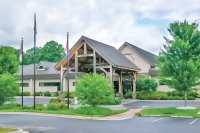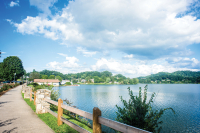WCU neighbors chagrinned by sprawling student apartments — and the cars they bring
Adam Cartwright walked a thin line on the way back to his home in Cullowhee. He hugged the side of Ledbetter Road, feet on the white paint, and frequently stepping off the pavement onto the scrubby grass if he heard a car approaching.
The narrow strip of grass was his only safe harbor, and false sense of security, between the rushing river to his right and the stream of traffic to his left.
A logging truck, as wide as its lane, thundered by.
“It can be dangerous walking along here,” Cartwright said. “But it’s about the only way I got to get around.”
Cartwright doesn’t have a car, so he has to walk from his mobile home in the nearby River Park to the convenience store or the Laundromat in Cullowhee. So the thought of yet another giant student housing complex — injecting a few hundred more students and their vehicles onto Ledbetter Road — concerns him, as it does many in the community.
Already, the once-rural road — absent of sidewalks, shoulders and bike lanes — provides the only access to several large housing complexes that serve Western Carolina University students. During the past decade or so, projects like University Suites, the Villas at WCU and the Maples of Cullowhee have sprouted up in the neighborhood.
Related Items
The latest proposed project, Western Carolina Apartments, has already been approved by the Jackson County’s Planning Board. It is looking to add more than 450 additional beds along the busy road in an expansive, sprawling complex outfitted with basketball courts, a swimming pool, a clubhouse and several three-story buildings.
While the neighborhood around Ledbetter Road has developed over time, with increasingly larger and higher-end apartment complexes, the road has not kept up.
“We’ve seen traffic counts grow a huge amount,” said Scott Baker, the dean of Career Technologies at Southwestern Community College. “There are a lot of near misses.”
Baker lives along Ledbetter Road, but the road today is far different than the one he moved onto in 2000. At that time, the River Park trailer park was the largest development, and the road predominantly served single-family dwellings.
Nowadays, the road has become a hazard, Baker said.
As a cyclist, he feels for the other residents who utilize the dead-end road for non-motorized purposes — the students who decide to walk or bike the half-mile to campus or folks like Cartwright don’t have a choice.
They are left with few options except risking it along Ledbetter and hope that the youthful drivers, with a reputation for taking its tight curves a bit too fast, see them in time to react, and heaven forbid, aren’t texting or yakking on their phones.
“It’s not that bad unless people speed,” said Ledbetter Road resident Melissa Collier, who lives right near the Maples apartments. “I just wish people would drive slower.”
She said one of the biggest problems is the steep bank on one side of the road, which forces pedestrians to walk with their backs to traffic at times.
The situation wouldn’t be so bad if the road wasn’t also riddled with blind curves and fast drivers. Collier said she never walks the road but would consider it if there were a sidewalk.
If no improvements are made, traffic on the road is only expected to get worse.
The wait time to get through the intersection at the end of Ledbetter Road will nearly double after the apartments are built, according to a traffic study commissioned by the developers of Western Carolina Apartments. The time to get past the stop sign at Monteith Gap Road will jump from about 10 seconds to just under 20 seconds in the morning rush hour.
The additional traffic would downgrade the road on the N.C. Department of Transportation’s own grading system from a “B” to a “C.” However, the “C” grade is still acceptable by DOT standards, said DOT District Engineer Jonathan Woodard.
“There are a lot of stop sign intersections that have a lot longer wait than that,” he said.
The developer of the apartment complex countered complaints about more traffic by suggesting students would ride the WCU shuttle, which stops on Ledbetter Road right in front of the new apartments. However, that theory is likely flawed, based on student participation. The Cat-Tran gets so little use from off-campus students that university transit officials have indicated it may be discontinued.
Too narrow, too many cars
The biggest concern for residents, however, is not the extra 10 seconds at an intersection. It is the safety of the road.
Baker and a contingent of Ledbetter residents have voiced their concerns to the county and N.C. DOT over Western Carolina Apartments.
“We’re not rioting in the streets against this apartment complex,” Baker said. “We’re just concerned about the traffic.”
At the urging of the Cullowhee community, county commissioners are appointing a task force to craft development standards to guide growth in the area. But regulations are a year away at best — too late to help the residents of Ledbetter Road.
The group of residents has appeared at public meetings to vocalize their reservations about the future development, sent correspondence to county and state officials, and recently finished a petition to call attention to the road conditions and demand improvements.
Their requests are numerous: a widened roadway, improved curves, an additional guardrail, a lower speed limit, sidewalks and bike lanes. These are all the features the current road lacks.
The new development won’t be on the hook for any of the improvements, however, according to DOT’s Woodard. The road was already inadequate; while Carolina West Apartments might make it worse, they can’t be solely responsible for fixing it.
“We can’t really ask them to come in and create improvements for a deficiency that was already there,” Woodard said.
DOT sometimes requires minor improvements of a developer if their project will disrupt traffic flows, like a turn lane.
To see a full slate of upgrades Ledbetter Road will have to beat out other future road projects through DOT’s ranking system, a joint process that considers technical analysis of road needs plus local community input.
Although not a perfect system, Woodard said it’s a way to work with the resources available.
“There’s a finite amount of funding,” Woodard said. “The intent is to take that funding and spend it on the best projects we can.”
Thus far, Ledbetter Road hasn’t made it on the list. But with the new apartments coming as early as fall 2014 and the amount of discontent displayed by Cullowhee residents, Woodard said the DOT is giving the road another look. It will draw up a prototype for improvements to Ledbetter Road and the road it empties onto, Monteith Gap Road. But that doesn’t guarantee it will be selected as one of the top projects in January, when the next cycle of road funding begins.
Pushing the boundaries
The controversy over Western Carolina Apartments embodies the dilemma the community of Cullowhee as a whole is faced with — a dense university population expanding into what was once an undeveloped rural area.
WCU broke enrollment records last fall with 9,600 students. Of those, more than 7,500 were enrolled in at least one Cullowhee-based class.
WCU’s on-campus residence halls have a total of 4,000 or so beds — and they were all full.
That’s led off-campus developers to swoop in to capture the student market, or steal the market from existing apartments that can’t compete with the high-end amenities newer housing complexes offer.
WCU has no plans to build more dorms or housing in the near future — due both to space limitations and budget constraints — making private housing developers the only players in the game.
“There is opportunity for off-campus developers to help address that need,” said Sam Miller, WCU vice chancellor for student affairs. “Residence halls are very expensive to build and wouldn’t it be better for the long term to upgrade classrooms and laboratories?”
Meanwhile, as off-campus housing expands, alternative transportation in Cullowhee is either non-existent, or not ideal.
Just last week, construction began on a sidewalk linking the main campus to the university’s Millennial Campus and its new Health and Human Sciences Building. The hope is that students will now have the option of safely walking the three-fourths of a mile from the main campus along Little Savannah Road, but the sidewalk will stand as one of the few in Cullowhee off campus.
“The inside portion of the university has a lot of sidewalks,” N.C. Department of Transportation District Engineer Jonathan Woodard said. “But as it starts to expand out into an area that was more a rural area before, the needs for transportation is expanding with it.”
Community members have been pushing for a sidewalk between campus and the old Cullowhee business district. But the DOT, university and community advocates haven’t figured out a solution for who would maintain the stretch of sidewalk beyond the campus limits. The DOT doesn’t want to, nor does the university, and as yet, no other entity has emerged to make it a reality.









